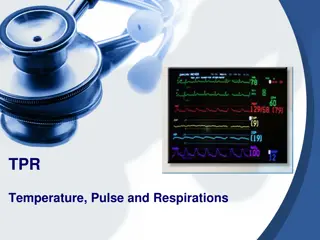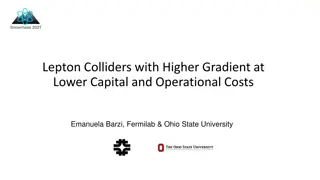Temperature, Heat, and Expansion - Chapter 14 & 15 Recap
This text explains the concepts and relationships between temperature, heat, energy, and expansion. It discusses different temperature scales and the idea of thermal equilibrium. It also covers the difference between temperature and heat, as well as how heat is measured.
10 views • 28 slides
Radar Attenuation Tomography for Mapping Englacial Temperature Distributions
Radar Attenuation Tomography is used to map the temperature distributions within the ice sheet by analyzing the radio waves' attenuation properties. This study focuses on the Eastern Shear Margin of Thwaites Glacier, where fast-moving ice meets slower ice, impacting ice rheology influenced by temper
4 views • 18 slides
Understanding Temperature Distribution and Differences in Heat
Explore the distribution of temperature across latitudes and elevations, and learn about the difference between heat and temperature. From horizontal to vertical variations, discover how factors like latitude influence temperature distribution patterns globally. Gain insights into the fundamental co
11 views • 19 slides
Do Input Gradients Highlight Discriminative Features?
Instance-specific explanations of model predictions through input gradients are explored in this study. The key contributions include a novel evaluation framework, DiffROAR, to assess the impact of input gradient magnitudes on predictions. The study challenges Assumption (A) and delves into feature
0 views • 32 slides
Exploring Weather through Infrared Temperature Detection
Studying everyday weather using infrared temperature detection from the environment can help in understanding the relationship between temperature variations of different objects and weather conditions. This activity involves creating hypotheses and testing them using an infrared temperature sensor.
0 views • 20 slides
Understanding Active Transport and Osmosis in Biology
Substances can be absorbed against concentration gradients through active transport, requiring energy from respiration. Cells use transport proteins to move substances across membranes. Osmosis involves the movement of water across a selectively permeable membrane along concentration gradients. The
4 views • 12 slides
Understanding Temperature and Color Relationship in Candle Flames
Explore the relationship between temperature and color in candle flames through the three zones model. By conducting experiments using a thermocouple sensor, investigate how the color gradient in a flame correlates with its temperature variations. Learn about the structure of a candle flame, the inf
1 views • 21 slides
A Comprehensive Guide to Gradients
Gradients are versatile tools in design, allowing shapes to transition smoothly between colors. Learn about gradient types, preset options, creating your own metallic gradients, and applying gradients effectively in this detailed guide. Explore linear and radial gradient directions, understand gradi
0 views • 7 slides
Exploring Temperature: Facts, Measurement, and Scales
Understanding temperature is crucial in daily life. This content delves into the definition, measurement, and scales of temperature, highlighting key facts such as body temperature, freezing and boiling points of water, and extreme temperatures like those found in lightning and the sun. Discover how
1 views • 9 slides
Understanding Temperature Effects on Donor and Acceptor Ionization in Semiconductors
Temperature plays a crucial role in the ionization of donor and acceptor atoms in semiconductors. In N-type semiconductors, the Fermi level lies below the conduction band, while in P-type semiconductors it lies above the valence band, with the position depending on temperature and impurity atoms. Do
1 views • 13 slides
Understanding Body Temperature Regulation
Explore how the body maintains its internal temperature through mechanisms such as correcting overheating and overcooling, the role of thermoreceptors, and voluntary responses that help control temperature. Discover the importance of regulating internal body temperature for optimal enzyme-catalyzed
2 views • 18 slides
Understanding Rates of Change and Calculus Concepts
Exploring the concept of rates of change through examples like finding the equation of a line passing through given points and understanding differentiation to calculate gradients and speeds. The relationship between gradients, curves, and tangents is highlighted to illustrate how calculus helps in
1 views • 21 slides
Calculus Examples and Practice
Explore various calculus problems involving finding gradients, equations of tangents and normals, and analyzing curves. Practice determining gradients at specific points, solving for coordinates, and differentiating equations to find tangent and normal lines. Understand the relationship between grad
1 views • 11 slides
Understanding Temperature and Friction in Metal Forming Processes
Metal forming processes are influenced by temperature and friction. At different temperature ranges, such as cold, warm, and hot working, the mechanical properties and forming behaviors of metals vary significantly. Cold working offers advantages like higher accuracy and strength, while warm working
0 views • 7 slides
Understanding Atmospheric Thickness and Its Applications
Atmospheric thickness refers to the difference in geopotential height between two pressure surfaces, which is dependent on the mean virtual temperature of the layer in between. This concept plays a key role in determining temperature gradients, identifying fronts, and aiding in weather forecasting,
0 views • 11 slides
Understanding Heat and Temperature in Thermodynamics
Thermal energy transfer, heat, and temperature play crucial roles in determining the behavior of systems in terms of kinetic energy and molecular motion. The zeroth law of thermodynamics establishes the relationship between heat and temperature. Heat transfer leads to changes in the average kinetic
8 views • 8 slides
Understanding Temperature Measurement in Plant Growth
Exploring the measurement of maximum and minimum air temperature, its significance in analyzing trends and variations, and how temperature impacts plant growth stages. The optimal temperature ranges for different plant species and the importance of maximum and minimum temperature recordings using sp
0 views • 20 slides
Understanding Social Gradients in Health and Socioeconomic Status
This presentation delves into the complexities of social gradients in health and socioeconomic status, highlighting the impact of indicators such as employment status, education, poverty, and housing tenure. It emphasizes the need to reassess indicators used for determining socioeconomic status and
2 views • 7 slides
Understanding Temperature Measurement in Healthcare
Temperature, Pulse, and Respirations are vital signs used to assess a patient's health. Temperature can be measured through various methods such as oral, rectal, axillary, tympanic, and temporal routes using different types of thermometers. It's important to know the normal temperature ranges for di
3 views • 39 slides
Anomalous Heat Transport in Mathematical Physics
Anomalous heat transport deviates from standard Fourier law, exhibiting divergent heat conductance and non-trivial temperature profiles. Observations include long-range time correlations and divergent temperature gradients at boundaries. Models like coupled oscillators and hard disks with alternatin
0 views • 43 slides
Mineral Absorption in Plants: Mechanisms and Types
Plants absorb minerals from the soil as ions through the roots, with the process of mineral absorption being distinct from water absorption. Mineral absorption in plants can occur through passive or active methods, each involving different mechanisms and energy requirements. Passive absorption is a
0 views • 14 slides
The Phenomenology of Temperature Awareness in Distance Running
Researchers at the University of Gloucestershire explore the embodied consciousness of distance runners, focusing on thermoception and temperature regulation. Utilizing sociological phenomenology and phenomenological ethnography, the study delves into the sensory experiences of runners, emphasizing
0 views • 29 slides
Exploring Temperature: From Touch to Thermometer
Explore the concept of temperature in Year 4 lesson 1, understanding that touch is not always accurate in judging temperature. Engage in activities to test different temperatures and discover the limitations of using the sense of touch. Lesson 2 introduces using a thermometer to measure temperature
0 views • 43 slides
Comprehensive Solution for EU Digital COVID Certificate Verification
This solution offers face recognition, temperature monitoring, and verification of EU Digital COVID Certificates for personnel. It includes products like DHI-ASI7213X-V1-T1 and ASF172X-T1, with various unlocking modes and support for certificate verification. The system allows for accurate and fast
0 views • 7 slides
Understanding Active Transport of Molecules: Driven by ATP Hydrolysis
Active transport, fueled by ATP hydrolysis, facilitates the movement of molecules against their concentration gradients, essential for processes like ion pumping across membranes. The Na+-K+ pump, a prime example, utilizes ATP to transport Na+ and K+ ions across cellular membranes, maintaining impor
0 views • 23 slides
Advancements in Lepton Colliders Technology
Emanuela Barzi and co-authors have made significant progress in developing lepton colliders with higher gradients at lower capital and operational costs. Their research focuses on using Superconducting Nb3Sn coated Cu RF cavities, parallel-feed RF structures, and innovative technologies to achieve h
0 views • 9 slides
Understanding Heat, Temperature, and States of Matter
Exploring the concepts of heat and temperature in relation to the kinetic theory of matter, this content delves into the difference between heat and temperature, the kinetic energy of particles, temperature scales, thermal energy, and specific heat. It also provides formulas for temperature conversi
0 views • 10 slides
Low Temperature Thermometry Overview
Temperature measurement, known as thermometry, involves assessing local temperature levels for various applications. A good low-temperature thermometer should offer reproducibility, high sensitivity, and a wide operating range. Primary thermometers directly measure properties of matter, while second
0 views • 25 slides
Understanding Temperature Measurement in Mechanical Engineering
Exploring the concepts of temperature measurement in mechanical engineering, this article covers topics such as temperature scales, the ideal-gas thermometer, and the relationship between temperature and heat. With detailed explanations and visual aids, it provides insights into how temperature is m
0 views • 25 slides
Understanding Temperature Measurement with Thermometers
Explore the principles of temperature measurement through thermometers, understanding phase changes, behavior of gases, and creating temperature scales. Compare weather forecasts between Moscow and Washington, discussing which city will be warmer and predicting precipitation types. Dive into discuss
0 views • 14 slides
Developing a Food Temperature Probe with BBC micro:bit
Design and develop a programmable system using the BBC micro:bit to create a prototype food temperature probe. The system should include a temperature sensor to detect food temperature, a buzzer to sound a warning if the food is too cold, and an LED screen to display the food temperature. Follow the
0 views • 9 slides
Quality Control and Testing Procedures for Superconducting Radiofrequency Cavities
The presentation highlights the rigorous processes involved in qualifying superconducting radiofrequency (SRF) cavities for high-performance applications. Each cavity undergoes a detailed qualification process, including BCP treatment, electropolishing, and high-pressure rinsing, to ensure optimal p
0 views • 18 slides
Minimizing Field Tilts in Superconductive Cavities: 2011 ILC Tests at FLASH
Understanding the importance of achieving flat gradients in superconductive cavities, the 2011 ILC tests at FLASH led by Julien Branlard focused on minimizing field tilts. Various solutions and test approaches were explored to address the issue, with results indicating the impact of cavity tilt and
0 views • 25 slides
Understanding Frontogenesis and Frontolysis in Meteorology
Meteorology enthusiasts can explore the concepts of frontogenesis and frontolysis, the evolution of cyclones, and the role of the Norwegian School Meteorologists in describing fronts. Dive into the mechanisms behind the formation and weakening of horizontal temperature gradients, the interaction bet
0 views • 60 slides
Validation of Airborne Data & Modeling on Summer Temperature Gradients in Southern California
Spatial distribution of California coastal cooling trends from 1970-2010, analyzing temperature data across 241 sites. Changes in urbanization visualized through Landsat images for the LA area show a significant increase in urban cover over three decades.
0 views • 27 slides
Understanding Earth's Energy Balance and Temperature Variations
Earth's energy balance is crucial for maintaining atmospheric temperature and regulating daily and seasonal temperature changes. The net radiation, consisting of incoming shortwave and outgoing longwave radiation, plays a key role in this balance. Components such as sensible heat flux, latent heat o
0 views • 18 slides
Understanding Candle Flame Temperature through Color Zones Model
Explore the correlation between temperature and color in a candle flame using the three zones model. Learn how the different zones of a candle flame represent varying temperatures, from the blue basal region to the orange/brown incomplete combustion area. Conduct experiments to measure these tempera
0 views • 21 slides
Advancements in Superconducting Linear Colliders for ILC Energy Upgrades
Discussion on higher gradient expectations for SRF at the International Linear Collider (ILC) for energy upgrades beyond 3 TeV, highlighting advancements in single and multi-cell cavity gradients over three decades. Promising R&D paths include cold electropolishing, nitrogen infusion, advanced cavit
0 views • 15 slides
Understanding Body Temperature Regulation and Factors Affecting It
Body temperature regulation is a complex process involving the balance of heat production and loss. Factors like age, hormones, stress, and environmental changes can influence body temperature. Heat production is affected by factors such as basal metabolic rate, muscle activity, fever, and sympathet
0 views • 24 slides
Temperature Tolerance of Organisms in the Universe
Life on Earth exists within a range of temperatures, with organisms displaying varied temperature tolerance. Eurythermal organisms can withstand large temperature fluctuations, while stenothermal organisms tolerate only small variations. The temperature range for each species is crucial for their ph
0 views • 8 slides






































